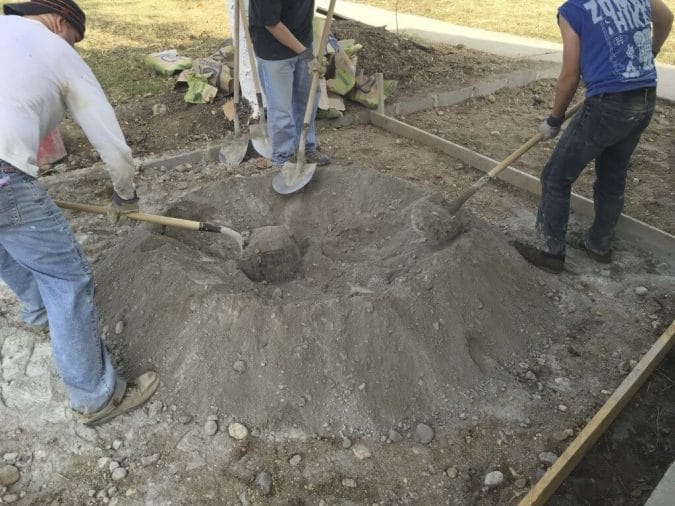How to Estimate Concrete Costs?
Concrete work in a project usually holds the maximum weightage in terms of overall cost and work quantity. It therefore becomes an important step to calculate the concrete related costs while preparing a project estimate. The cost of concrete depends upon the cost of materials, mix design, workforce, and machinery.
In this article we calculate the cost of 1 cubic meter of concrete and other expenses that occur in the preparations of concrete.
Factors that Affect the Cost of Concrete
1. Material Costs
Costs of materials and supplies and the associated shipping charges influence the cost of any concrete construction project.
2. Labor Rates
The local labor rates or wages specified by the state affect the expenditure of a project.
3. Site Conditions
The location and the prior site condition affect the cost of the project and concrete. Poor soil quality, wetlands, contamination, utility, environmental and traffic issues are few examples in this category.
4. Schedule
If the project schedule is too short for the type of work involved, then project costs tend to be on the higher side. This is especially true for projects with a significant liquidated damage clause in their contracts.
5. Contingency
A 10% contingency fund of the total expenditure is generally set aside by cement contractors to cover unforeseen costs. However, inflation and scarcity of materials and supplies might require a higher contingency of the range of 15-20%.
Calculation of Cost for 1m3 of Concrete
Let’s consider the concrete mix of M15 (1:1.5:3), where, 1 is the part of cement, 1.5 is the part of fine aggregates and 3 is the part of coarse aggregates of maximum size of 20mm. The water-cement ratio required for mixing of concrete is taken as 0.45.
1. Assumptions:
Bulk Density:
1. Cement = 1500 kg/m3
2. Sand = 1700 kg/m3
3. Coarse aggregates = 1650 kg/m3
1. Cement = 1500 kg/m3
2. Sand = 1700 kg/m3
3. Coarse aggregates = 1650 kg/m3
2. Calculation of Materials for
1m3 Concrete
Dry volume = Wet Volume X 1.54
Volume of cement required = (Dry volume X Cement ratio)/ Sum of ratio
Volume of Cement = (1 X 1.54)/(1+1.5+3)
= 1.54/5.5
= 0.28m3
Weight of the cement = 0.28 X 1500
= 420 kg.
Volume of cement required = (Dry volume X Cement ratio)/ Sum of ratio
Volume of Cement = (1 X 1.54)/(1+1.5+3)
= 1.54/5.5
= 0.28m3
Weight of the cement = 0.28 X 1500
= 420 kg.
Volume of Sand = (1.5 X 1.54)/(1+1.5+3)
= 2.31/5.5
= 0.42m3
Weight of the Sand = 0.42 X 1700
= 714 kg.
= 2.31/5.5
= 0.42m3
Weight of the Sand = 0.42 X 1700
= 714 kg.
Volume of Course Aggregate= (3 X 1.54)/(1+1.5+3)
= 4.62/5.5
= 0.84m3
Weight of the Course Aggregate = 0.84 X 1650
= 1386 kg.
= 4.62/5.5
= 0.84m3
Weight of the Course Aggregate = 0.84 X 1650
= 1386 kg.
3. Cost Calculation
Cost of cement for 1 m3 =
No of Bags = 420/50
=8.4 Bags
As per latest market rate, cost of 1 bag of cement is taken as Rs: 450
= 8.4 X 450
= 4200 Rs
No of Bags = 420/50
=8.4 Bags
As per latest market rate, cost of 1 bag of cement is taken as Rs: 450
= 8.4 X 450
= 4200 Rs
Cost of sand for 1 m3 =
As per latest market rate, cost of 1 m3 of sand is taken as Rs: 1400
= 0.42 X 1400
= 588 Rs
As per latest market rate, cost of 1 m3 of sand is taken as Rs: 1400
= 0.42 X 1400
= 588 Rs
Cost of course aggregate for 1 m3 =
As per latest market rate, cost of 1m3 of course aggregate is taken as Rs.2400
= 0.84 X 2400
= 2016 Rs
As per latest market rate, cost of 1m3 of course aggregate is taken as Rs.2400
= 0.84 X 2400
= 2016 Rs
Therefore total cost of 1m3 of M15 concrete is
=Cost of cement + sand + course aggregate
= 4200 + 588 + 2016
Say Rs 6400
=Cost of cement + sand + course aggregate
= 4200 + 588 + 2016
Say Rs 6400
Additional Cost of Concrete
The above cost given is just for the raw materials of concrete. The complete cost of concrete includes the cost of mixing, transporting, compaction equipment, reinforcement, formwork and labour charges.
1.Mixing

The cost involved in the transportation of materials into the mixer and the mixer charges are added to the concrete.
2. Transportation
The mixed concrete is to transported to the concreting location with the help of machines and labours.
3. Compaction
The charges involved in the usage of compaction machines such as vibrator and other tools are also added up to the total cost of concreting .

4. Reinforcement

If the concrete is reinforced, the cost of steel and labour charges for the cutting and tieing of rebars is also calculated and added to the concrete works.
5. FormWork or Shuttering
If the concrete work is done for beam, columns or slab, the formwork required to hold the concrete is also added.

6. Skilled Labour
The man force required to mix, transport, place, compact and finish the concrete is added to the concreting work cost.






No comments:
Post a Comment
Thanks for Comments